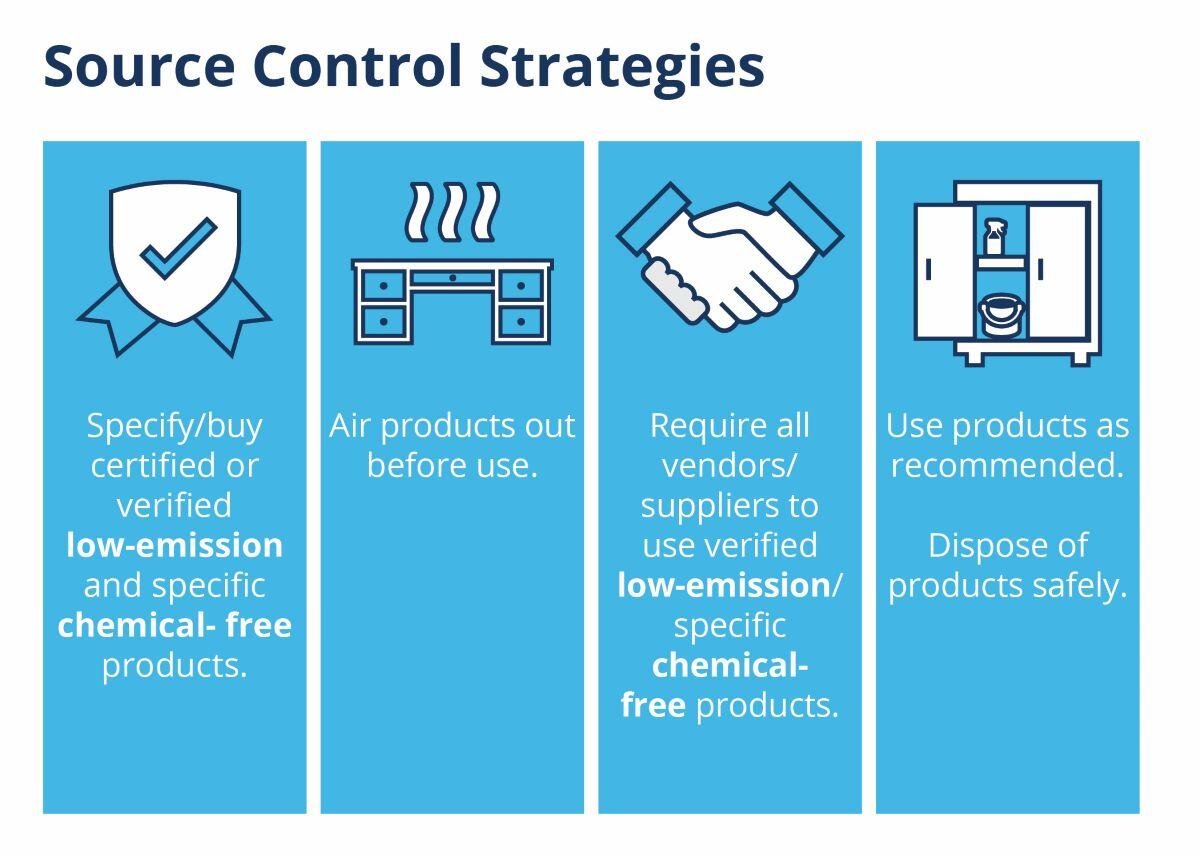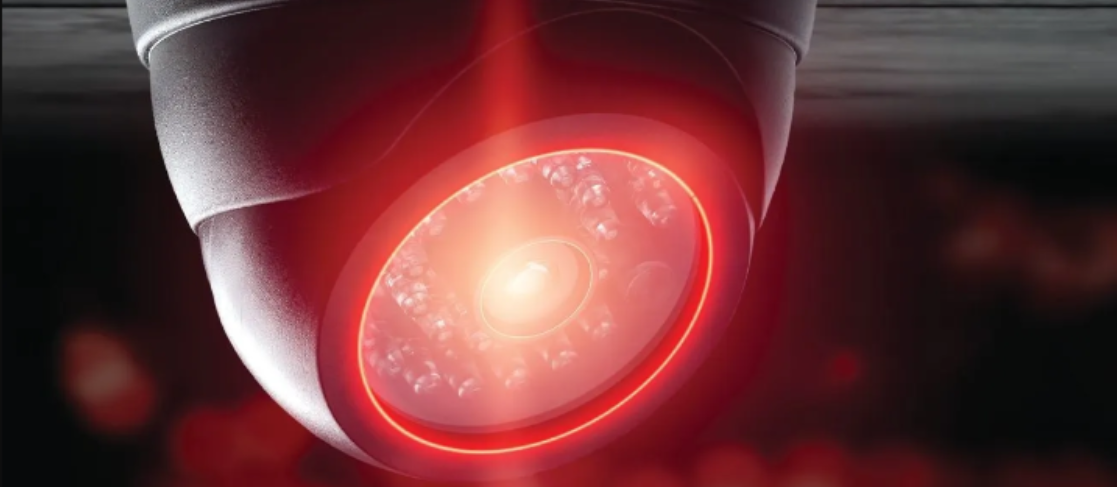Creating a Healthy Indoor Environment
Reducing chemical air pollutants’ impact

Facility managers are charged with maintaining good indoor air quality (IAQ) that leads to healthy, happy and productive occupants. Poor IAQ can lead to a 6 to 9 percent loss in work performance and productivity and dissatisfaction among visitors.
FMs have heard similar questions:
- Is this building making me sick?
- Is the air in this space healthy and clean?
- What’s that smell?
These are real questions and understanding what is in the indoor air and what the sources of pollutants are can help provide answers. Once FMs have command of knowing what is in the indoor air, what is normal and what to be concerned about, it is easier to develop a source control and building management plan to avoid unnecessary concern or anxiety among occupants.
Occupants can be exposed to 200–1,000 chemicals in a building at any one time.
Managing chemicals in buildings must be strategic with a focus on those that present a greater risk to health. These may include chemicals recognized or known as carcinogens (can cause cancer), neurotoxins (affect nerves and neurological systems), reproductive toxins (affect reproductive and endocrine systems) and irritants (result in headaches, eye, ear and throat irritation, and common flu symptoms). Keep in mind that vulnerable groups of people can be more significantly affected by exposure. These include children, pregnant women, aged populations, immunocompromised people, those on drug therapies and groups of people with limited access to health care.
Most chemicals come from one of three places: Products, processes or people. Targeted management and control is possible.
 All these chemicals affect the quality of the air breathed by building occupants, but FMs also must be concerned about chemicals that stick to dust that can settle onto furniture and surfaces such as flooring, tabletops and shelving. If not properly removed, this building dust can be inhaled, or could be ingested when it gets onto the hands of occupants.
All these chemicals affect the quality of the air breathed by building occupants, but FMs also must be concerned about chemicals that stick to dust that can settle onto furniture and surfaces such as flooring, tabletops and shelving. If not properly removed, this building dust can be inhaled, or could be ingested when it gets onto the hands of occupants.
So, what are some of the types of chemicals of concern for FMs? They generally fall into two categories, volatile organic compounds (VOCs) or semi-volatile organic compounds (SVOC), depending on how quickly they can evaporate into the air.

.jpg?width=1200&height=857&name=FMJ_2%20(1).jpg)
Some examples of commonly found VOCs of concern include formaldehyde, a carcinogen and strong respiratory irritant which is typically associated with manufactured wood products such as cabinetry, shelving and furniture. Benzene is also a carcinogen and is introduced in buildings via cleaning solvents and outdoor air. Terpenes are VOCs such as limonene or pinene that are used to add a lemon or orange fragrance to solvents and cleaning chemicals. While the terpene odor can be irritating to occupants, the real hazard is their ability to react with indoor ozone to produce very fine particles or ultrafine particles that can be inhaled and damage the cardiovascular system of people.
8% of the U.S. population also has a skin contact allergy to formaldehyde
SVOCs are of concern because they evaporate from products slowly and can exist in buildings for an extended time. Some of the newly recognized SVOCs of concern are per- and polyfluoroalkyl substances or PFAS. PFAS chemicals contain a very strong carbon-fluorine bond, and as a result, they will not break down and will build up in the human body and the environment. They are known as forever chemicals. These toxic fluorinated chemicals have been linked to cancer and reproductive harm and are found in many products with stain and soil resist properties as well as numerous consumer products, textiles and even building wiring.
More than 90% of the U.S. population has PFAS chemicals in their bodies
Other SVOCs of concerns include phthalates that are added to plastics to make them softer and more flexible; and flame retardants added to products to make them more resistant to fire ignition. Sources of phthalates can include vinyl flooring, plastic packaging, oils and soaps, and specific phthalates include dibutyl phthalate and bis (2-ethylhexyl) phthalate. Flame retardants in buildings can be found in numerous products including building materials, furniture, foam insulations, cables and electrical wiring, and electronic equipment. Specific flame retardants include tetrabromobishenol A (TBBPA), common in electronics and various organophosphate flame retardants (OPFRs) found in insulations, textiles and various building materials. Certain phthalates and flame retardants have been associated with numerous health concerns including endocrine and thyroid disruption, cancer and reproductive toxicity.
Maintenance & mitigation strategies for VOCs + SVOCs
Source control is the No. 1 strategy to maintain good air quality and reduce exposure to chemicals. It is a lot easier to not bring pollutants into a space than to try to eliminate them afterward.

Effective and safe cleaning processes include the use of nontoxic and low emission chemicals; frequent vacuuming with a HEPA vacuum on all surfaces; continued focus on the disinfection of high-touch surfaces such as door handles and water faucets; operating HVAC systems during cleaning or making sure windows are open; and having a routine cleaning schedule. Chemical Insights Research Institutes’ (CIRI) research has found that an effective cleaning program can reduce occupant absenteeism and respiratory complaints.
Finally, it is extremely important to have a good ventilation system in operation during all building occupant times. Although it is impossible to flush out all chemical pollution, ventilation can work in conjunction with good source control to dilute and filter out pollution. Key requirements for ventilation include:
- A properly working HVAC system to dilute pollutants and transport them outside while always including 15-20 percent of outdoor air.
- Proper air mixing so that the supply air is reaching the occupant level.
- Air filtration using the highest MERV rated filter possible; a minimum of MERV 13 recommended.
- Use only ducted supplies and returns and no open plenum returns.
- Keep the system running for at least two hours before and after occupancy.
- Have ventilation performance meet ANSI/ASHRAE 62.1- 2022.
Source control, cleaning, ventilation and filtration are all key components to a healthy indoor air environment, but it does not stop there. FMs must work with occupants on education and staff training by encouraging reporting of IAQ issues immediately and establishing facility policies that reinforce healthy indoor environments. FMs can inform occupants about efforts through newsletters, signage, general communications and the development of a management plan that incorporates the strategies presented.


Dr. Marilyn Black is vice president and senior technical advisor for Chemical Insights Research Institute of UL Research Institutes. She is the founder and former chairperson for both UL Air Quality Sciences and the GREENGUARD Environmental Institute. She is also the founder of the Khaos Foundation, a non-profit organization dedicated to protecting the health and well-being of children through education and research. Dr. Black is an active participant in national and international scientific organizational initiatives, research and community outreach initiatives and has presented and published extensively on IAQ, chemical exposure and healthy, sustainable buildings. She received a Ph.D. from the Georgia Institute of Technology, a master’s degree from the University of Florida and a bachelor’s degree from the University of Virginia.
Read more on Operations & Maintenance , Risk Management and Emerging Topics
Explore All FMJ Topics









